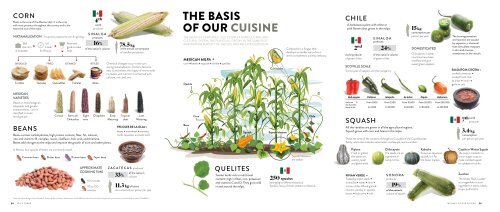ven-a-comer-e-book-en_1
ven-a-comer-e-book-en_1
ven-a-comer-e-book-en_1
You also want an ePaper? Increase the reach of your titles
YUMPU automatically turns print PDFs into web optimized ePapers that Google loves.
CORN<br />
Maize is the core of the Mexican diet. It is the crop<br />
with most pres<strong>en</strong>ce throughout the country and is the<br />
heart and soul of the milpa.<br />
NIXTAMALIZATION This process prepares the corn for grinding:<br />
Boil<br />
the corn<br />
in limewater.<br />
GRIDDLED<br />
Tortillas<br />
Let<br />
it soak<br />
for 8 hours.<br />
Rinse and<br />
grind to make<br />
masa.<br />
th<br />
world<br />
producer<br />
SINALOA<br />
produces:<br />
FRIED STEAMED BOILED<br />
6%<br />
’ . kg<br />
of the nation’s volume<br />
Tostadas Quesadillas Tamales Atole<br />
is the annual consumption<br />
of tortillas per person<br />
Chemical changes occur in the corn<br />
during nixtamalization. Proteins become<br />
easy to assimilate, the supply of amino acids<br />
increases, and nutrition is <strong>en</strong>hanced with<br />
calcium, iron, and zinc.<br />
THE BASIS<br />
OF OUR CUISINE<br />
THE MILPA IS A CENTURIES-OLD, COMPLEX AGRICULTURAL AND<br />
CULTURAL SYSTEM. THE PLANTS ALL GROW ON THE SAME PLOT,<br />
MAINTAINING FERTILITY OF THE SOIL AND REDUCING EROSION.<br />
MEXICAN MILPA =<br />
corn+ beans + squash + chiles + quelites<br />
Quelite<br />
Cuitlacoche<br />
Cuitlacoche is a fungus that<br />
develops on t<strong>en</strong>der ears of corn<br />
and is considered a culinary delicacy.<br />
CHILE<br />
A herbaceous plant with white or<br />
pink flowers that grows in the milpa.<br />
nd<br />
world producer<br />
of gre<strong>en</strong> chiles<br />
SCOVILLE SCALE<br />
SINALOA<br />
produces:<br />
%<br />
of the nation’s volume<br />
of gre<strong>en</strong> chiles<br />
Some types of peppers and their pung<strong>en</strong>cy:<br />
kg<br />
consumption per<br />
person per year<br />
DOMESTICATED<br />
Chile plants in other<br />
countries have be<strong>en</strong><br />
modified and give<br />
sweet gre<strong>en</strong> peppers.<br />
The burning s<strong>en</strong>sation<br />
and reaction are caused<br />
by capsaicin, a chemical<br />
that stimulates receptors<br />
in skin and mucous<br />
membranes in the mouth.<br />
SALSA ROJA COCIDA =<br />
cooked tomatoes +<br />
cooked fresh chile<br />
de árbol + onion +<br />
garlic + salt<br />
MEXICAN<br />
VARIETIES<br />
Bell pepper<br />
Poblano<br />
Jalapeño<br />
de árbol<br />
Piquín<br />
Habanero<br />
Based on morphological,<br />
adaptable, and g<strong>en</strong>etic<br />
characteristics, corn is<br />
classified in se<strong>v<strong>en</strong></strong><br />
racial groups:<br />
BEANS<br />
Conical<br />
Sierra de<br />
Chihuahua<br />
Eight<br />
rows<br />
Chapalote<br />
Beans contain carbohydrates, high protein cont<strong>en</strong>t, fiber, fat, calcium,<br />
iron and vitamins: B-complex, niacin, riboflavin, folic acid, and thiamine.<br />
Beans add nitrog<strong>en</strong> to the milpa and improve the growth of corn and other plants.<br />
Early<br />
Maturing<br />
Tropical<br />
d<strong>en</strong>t<br />
Late<br />
Maturing<br />
FRIJOLES DE LA OLLA =<br />
beans + water + salt + aromatic<br />
herbs (epazote, avocado leaf)<br />
Cuitlacoche<br />
Bean<br />
Corn<br />
Squash<br />
Squash blossom<br />
Chile<br />
Units on 0 From 1,000<br />
the Scoville<br />
Heat Scale<br />
to 2,000<br />
SQUASH<br />
From 2,500<br />
to 10,000<br />
From 10,000<br />
to 30,000<br />
All the varieties are grown in all the agricultural regions.<br />
Squash grows with corn and beans in the milpa.<br />
From 30,000<br />
to 60,000<br />
These are some of the varieties of the g<strong>en</strong>us Cucurbita of the Cucurbitaceae<br />
family, which also includes watermelon, cantaloupe, and cucumber:<br />
:<br />
From 200,000<br />
to 350,000<br />
th world<br />
producer<br />
. kg<br />
consumption<br />
per person per year<br />
In Mexico four species of beans are commonly raised<br />
Common bean<br />
Butter bean<br />
Runner bean<br />
Tepari bean<br />
APPROXIMATE<br />
COOKING TIME<br />
60 minutes<br />
90 to 120<br />
minutes<br />
ZACATECAS produces:<br />
of the nation’s<br />
% volume<br />
. kg of beans<br />
are consumed per person per year<br />
QUELITES<br />
T<strong>en</strong>der herbs rich in nutritional<br />
cont<strong>en</strong>t: high in fiber, iron, potassium<br />
and vitamins C and D. They grow wild<br />
in and around the milpa.<br />
Squash blossoms<br />
are edible.<br />
species<br />
belonging to differ<strong>en</strong>t botanical<br />
families, many of them <strong>en</strong>demic to Mexico.<br />
Pipiana Chilacayote Kabocha Castile or Winter Squash<br />
Fried or grilled,<br />
The seeds are an<br />
Known as Japanese<br />
The pulp is cooked in a<br />
the seeds are<br />
ingredi<strong>en</strong>t in<br />
squash, it is for<br />
brown sugar syrup to<br />
used in pipián<br />
candy brittle.<br />
the Asian market.<br />
make candied squash<br />
and gre<strong>en</strong> mole.<br />
or calabaza <strong>en</strong> tacha.<br />
PIPIÁN VERDE =<br />
Toasted pumpkin seeds +<br />
tomatillos+ water + lard +<br />
serrano chiles + fried garlic+<br />
cilantro, parsley or epazote<br />
leaves + hoja santa + salt<br />
SONOR A<br />
produces:<br />
%<br />
of the nation's<br />
volume of squash<br />
Zucchini<br />
The t<strong>en</strong>der flesh is eat<strong>en</strong><br />
as a vegetable or as an<br />
ingredi<strong>en</strong>t in stews, salads,<br />
soups, and broths.<br />
Data: Secretaría de Agricultura, Ganadería, Desarrollo Rural, Pesca y Alim<strong>en</strong>tación (SAGARPA) and the Comisión Nacional para el Conocimi<strong>en</strong>to y Uso de la Biodiversidad (CONABIO).<br />
34 — V<strong>en</strong> a Comer<br />
the basis of our cuisine — 3 6


